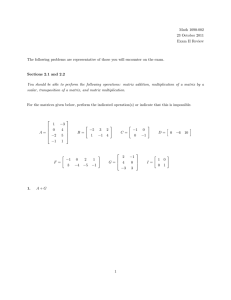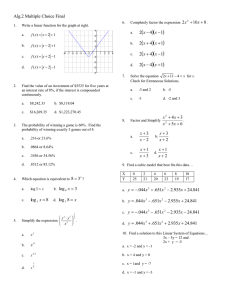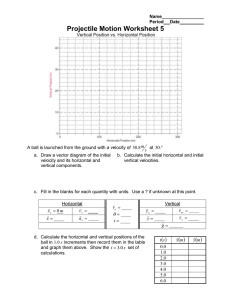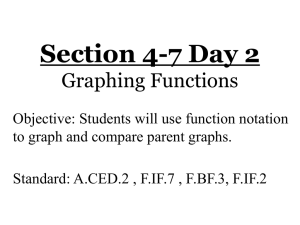Due: 28 October 2011 Math 1090-002 22 October 2011 Section 3.6 Homework
advertisement
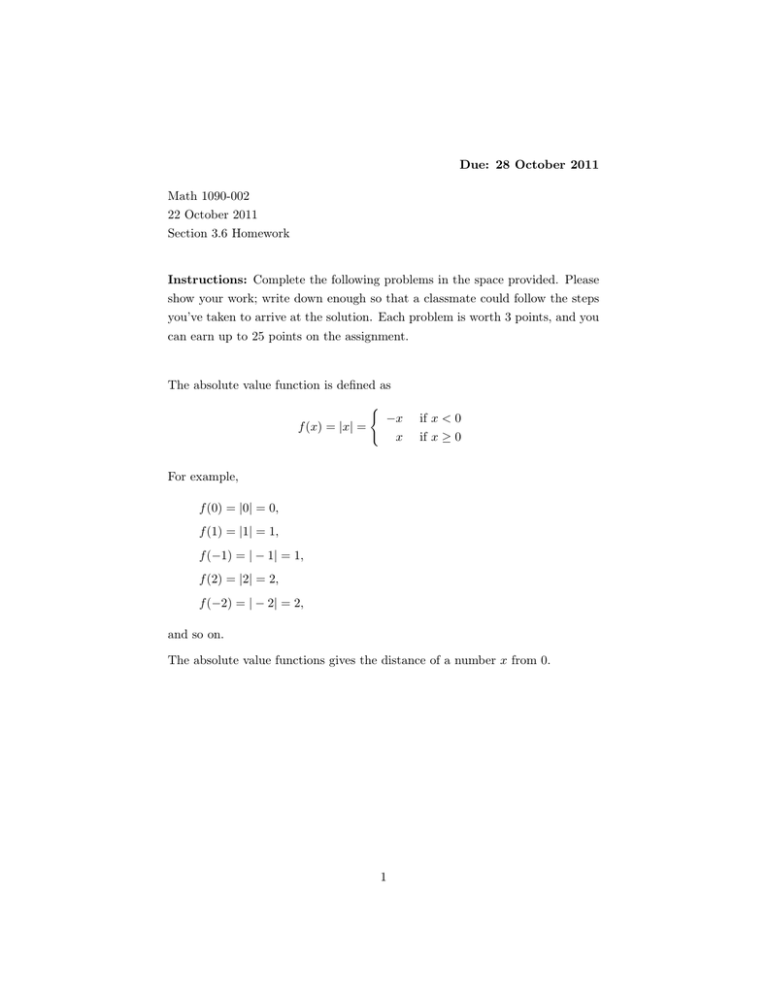
Due: 28 October 2011 Math 1090-002 22 October 2011 Section 3.6 Homework Instructions: Complete the following problems in the space provided. Please show your work; write down enough so that a classmate could follow the steps you’ve taken to arrive at the solution. Each problem is worth 3 points, and you can earn up to 25 points on the assignment. The absolute value function is defined as ( f (x) = |x| = −x if x < 0 x if x ≥ 0 For example, f (0) = |0| = 0, f (1) = |1| = 1, f (−1) = | − 1| = 1, f (2) = |2| = 2, f (−2) = | − 2| = 2, and so on. The absolute value functions gives the distance of a number x from 0. 1 The plot of this function is given below: The following functions are transformed versions of the base function y = f (x) = |x|. For each function, describe all transformations, and then draw the graph of the function on the axes provided. 2 1. y = g(x) = −|x|. (a) Vertical and/or horizontal shift? By how much? In which direction(s) (i.e. up or down, left or right)? (b) Vertical and/or horizontal reflection? (c) Vertical deformation (stretch or shrink)? By what factor? (d) Horizontal deformation (stretch or shrink)? By what factor? (e) Plot the function. 3 2. y = g(x) = | − x| + 3. (a) Vertical and/or horizontal shift? By how much? In which direction(s)? (b) Vertical and/or horizontal reflection? (c) Vertical deformation (stretch or shrink)? By what factor? (d) Horizontal deformation (stretch or shrink)? By what factor? (e) Plot the function. 4 3. y = g(x) = |2(x − 1)|. (a) Vertical and/or horizontal shift? By how much? In which direction(s)? (b) Vertical and/or horizontal reflection? (c) Vertical deformation (stretch or shrink)? By what factor? (d) Horizontal deformation (stretch or shrink)? By what factor? (e) Plot the function. 5 4. y = g(x) = −3| 12 (x + 1)| − 4. (a) Vertical and/or horizontal shift? By how much? In which direction(s)? (b) Vertical and/or horizontal reflection? (c) Vertical deformation (stretch or shrink)? By what factor? (d) Horizontal deformation (stretch or shrink)? By what factor? (e) Plot the function. 6 The square root function is defined as y = f (x) = For example, f (0) = f (1) = f (4) = f (9) = √ √ √ √ 0 = 0, 1 = 1, 4 = 2, 9 = 3, and so on. The plot of this function is given below: 7 √ x. The following functions are transformed versions of the base function y = f (x) = √ x. For each function, describe all transformations, and then draw the graph of the function on the axes provided. 8 √ 5. y = g(x) = − x − 4. (a) Vertical and/or horizontal shift? By how much? In which direction(s)? (b) Vertical and/or horizontal reflection? (c) Vertical deformation (stretch or shrink)? By what factor? (d) Horizontal deformation (stretch or shrink)? By what factor? (e) Plot the function. 9 6. y = g(x) = √ −x + 5. (a) Vertical and/or horizontal shift? By how much? In which direction(s)? (b) Vertical and/or horizontal reflection? (c) Vertical deformation (stretch or shrink)? By what factor? (d) Horizontal deformation (stretch or shrink)? By what factor? (e) Plot the function. 10 7. y = g(x) = √ 2x. (a) Vertical and/or horizontal shift? By how much? In which direction(s)? (b) Vertical and/or horizontal reflection? (c) Vertical deformation (stretch or shrink)? By what factor? (d) Horizontal deformation (stretch or shrink)? By what factor? (e) Plot the function. 11 √ 8. y = g(x) = 4 −x − 1 − 3. (a) Vertical and/or horizontal shift? By how much? In which direction(s)? (b) Vertical and/or horizontal reflection? (c) Vertical deformation (stretch or shrink)? By what factor? (d) Horizontal deformation (stretch or shrink)? By what factor? (e) Plot the function. 12

